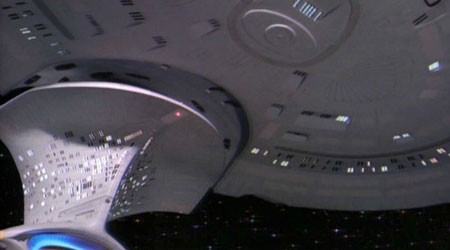Unlike the early days of space exploration when all crew and passengers aboard starships accepted certain dangers, the newest generation of Federation starships, such as the Galaxy class, have ample room and resources to support non-Starfleet passengers. Starfleet first designed saucer separation as a method to remove the crew and their families from danger in certain emergency conditions. Starfleet s largest starships are actually two space vehicle systems, the saucer section and the star drive section, that are capable of independent operation and combine to form a single operational starship.
Saucer separation can be used in a variety of situations; first if the starships warp core is dam aged beyond repair and headed toward a warp core breach, the saucer section can be used as a life boat to transport the entire crew beyond the blast radius of the exploding star drive section. Since the saucer section does not have warp capabilities the saucer section and crew will be stranded unti l rescued by Starfleet.
The starship can also be separated in anticipation of battle situations to remove non-essential personal from the battle zone, only a skeleton crew is left aboard the star drive section during combat. The ships star drive section contains the ships warp engines and majori ty of the ships weaponry; when relived of the bulk of its mass the star drive section becomes an effective battle platform and lives are not risked unnecessary.
A Galaxy class starship connects the star drive and saucer sections though a series of eighteen docking latches situated on the load beari ng points on the ships space frame. When saucer separation is initiated the latches will retract into the dorsal surface of the star drive section. While the latches are retracting, trubolifts and all other interconnecting supply and computer systems are sealed off, creating two independent vehi cles. Saucer separation can be accomplished at impulse or warp speeds.



